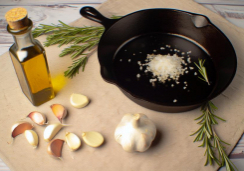Beginner's Guide to Healthy Stir-Fry Methods
Chopping, tossing, and sizzling—these are the symphonic movements that turn fresh ingredients into a vibrant stir-fry. You've likely heard that stir-frying is a healthy way to prepare your meals, but mastering the subtleties of this cooking method can be the difference between a dish that's merely passable and one that's truly exceptional.
As you embark on this culinary journey, keep in mind that the right combination of fresh produce, lean proteins, and heart-healthy oils is essential to creating a nutritious meal. By understanding how to layer flavors and textures, you can ensure that your stir-fries are not only good for you but also delightfully satisfying.
Stay tuned, as you're about to uncover the secrets behind crafting a perfectly balanced stir-fry that will invigorate your taste buds and broaden your cooking repertoire.
Choosing Your Ingredients
When selecting ingredients for your stir-fry, aim for a balanced mix of proteins, aromatic elements, and a variety of vegetables to ensure a meal that's both flavorful and nutritionally complete.
Your choice of proteins—whether it's chicken, beef, pork, seafood, tofu, or tempeh—will cater to different tastes and dietary needs, adding essential amino acids that support muscle repair and growth.
Don't overlook the importance of aromatic ingredients like garlic, green onions, shallots, or ginger. These elements impart rich flavors and aromas that are the hallmark of a great stir-fry.
When it comes to vegetables, the more colorful your selection—such as bell peppers, broccoli, snap peas, and mushrooms—the broader the spectrum of vitamins, minerals, and antioxidants you'll be serving up. These nutrients are vital for maintaining a healthy immune system and preventing chronic diseases.
If you've got leftovers, don't hesitate to toss them in. They can provide an unexpected twist in taste while helping to reduce food waste.
To maximize health benefits, focus on lean proteins, a rainbow of vegetables, and consider whole grains for added fiber.
With all your ingredients prepped and ready, you're set to create a stir-fry that's as nutritious as it's delicious.
Preparing Your Proteins
To ensure your stir-fry is both tender and flavorful, start by choosing a variety of proteins and slicing them against the grain before tenderizing them with a fork or a marinade. Select from chicken, beef, pork, seafood, tofu, or tempeh to add versatility to your meals. Slicing against the grain is crucial because it shortens the muscle fibers, enhancing the tenderness of your cooked protein.
When you marinate your protein, consider incorporating cornstarch or baking soda, which are known to break down tough fibers and increase juiciness. However, be mindful of marinating time; while it infuses flavor, excessive marination can result in a mushy texture. Aim for a balance that tenderizes without compromising the integrity of the protein.
Before you introduce your protein to the wok, cook it separately from the vegetables. This step is important because proteins and veggies have different cooking times. By cooking your protein on its own, you can sear it properly without it sticking, ensuring a flavorful crust and a perfectly cooked interior. Once your protein is cooked to your liking, you can then combine it with the rest of your stir-fry ingredients to finish the dish.
Selecting Healthy Oils
Having prepared your proteins for the stir-fry, it's equally important to choose the right oils that offer health benefits and withstand the high temperatures of stir-frying. When you're standing over your carbon steel wok, ready to sizzle and sear, the oil you pour in must be up to the task.
For high heat stir-frying, select oils with high smoke points to avoid burning and creating harmful compounds. Avocado oil, with its smoke point well above 400°F, is a perfect companion for the heat. It's rich in monounsaturated fats, which are heart-healthy and stable at high temperatures. Similarly, coconut oil is a sound choice, offering a unique flavor and saturated fats that remain stable when heated.
Also consider extra-virgin olive oil, a staple in health-conscious kitchens. It contributes good fats and a distinct taste that can elevate your dish. While its smoke point is lower than avocado or coconut oil, it can still perform well under the moderate high heat of stir-frying.
Lastly, balance is key. Oils with a good ratio of omega-3 to omega-6 fatty acids, like certain high-quality canola oils, support heart health and manage inflammation. So, as you heat up that wok, remember that the right oil not only cooks your food but also nurtures your well-being.
Mastering the Stir-Fry Technique
Mastering the stir-fry technique hinges on your ability to manage proper heat, ensure constant movement, and time each step precisely for a dish that's both flavorful and nutritiously cooked. This quick stir-fry method locks in nutrients while delivering a delightful smoky essence that's a hallmark of the cooking technique.
To truly become adept, consider these three core principles:
- Heat Mastery: Always preheat your wok or pan to a medium-high heat before adding ingredients. This high temperature sears the food quickly, creating a rich flavor without overcooking, which can diminish nutrients.
- Constant Motion: Keep your ingredients moving. Use a spatula to toss and turn your food continuously. This not only prevents sticking and burning but also promotes even cooking and texture, ensuring every bite is as tasty as the last.
- Precise Timing: Add ingredients based on cooking time; start with those that take the longest. Quick-cooking vegetables and proteins should be added later to avoid overcooking. By timing your steps, you'll preserve the vibrant colors and nutrients of your ingredients, making your stir-fry not just delicious but also packed with health benefits.
What Are the Health Benefits of Stir-Frying?
Stir-frying is a cooking method that retains the nutrients in food. By using minimal oil and cooking quickly over high heat, wholesome stirfry basics help to preserve the natural goodness of vegetables and meats. This results in a dish that is both flavorful and healthy, making it a popular choice for health-conscious individuals.
Balancing Flavors and Nutrition
Crafting a delicious stir-fry involves more than just tossing ingredients into a pan; it's about creating a harmonious blend of flavors while packing a nutritional punch. You'll want to gather a rainbow of vegetables, like vibrant snap peas, which not only add a satisfying crunch but also contribute essential vitamins and fiber.
Lean proteins, such as chicken or tofu, should be your go-to for muscle-building nutrients without excess fat. When it comes to sauces, a dash of soy sauce can provide that umami depth, while oyster sauce can offer a hint of sweetness and richness. However, it's crucial to balance the amount you use to avoid drowning your dish in sodium and extra calories.
Don't shy away from experimenting with herbs and spices—these can elevate your stir-fry from good to great without compromising the health benefits. Think garlic for its immune-boosting properties or ginger for its digestive aid.
Conclusion
You're now equipped to whip up healthy stir-fries that dazzle the taste buds while nourishing your body.
Remember, go for colorful veggies, lean proteins, and heart-healthy oils.
Keep that wok sizzling over high heat and toss your ingredients briskly—it's key to locking in flavor and nutrients.
So, balance your sauces for a taste punch with benefits, and don't be afraid to experiment.
Each stir-fry is a step closer to mastering a timeless culinary art that's as healthy as it's delicious.










